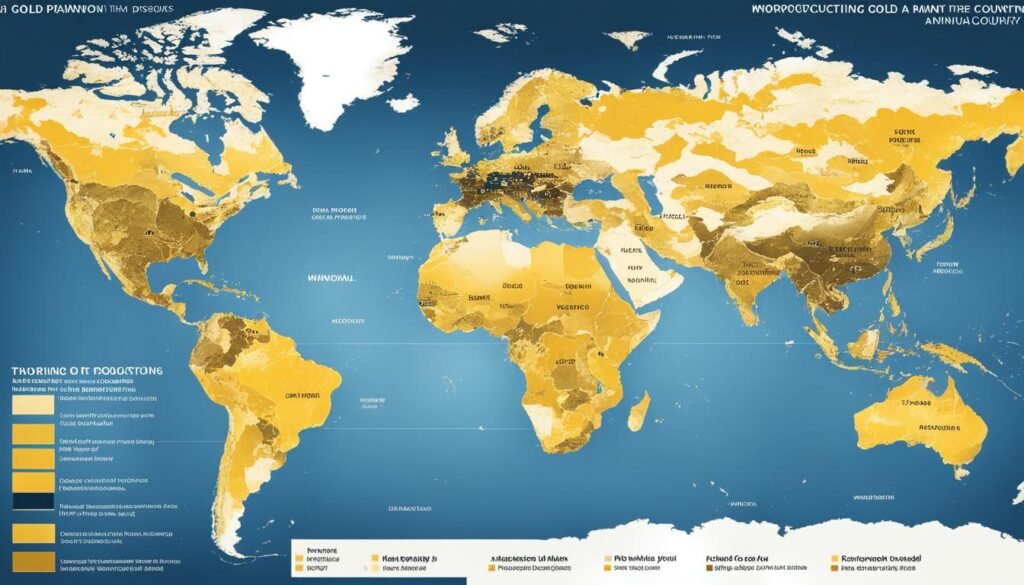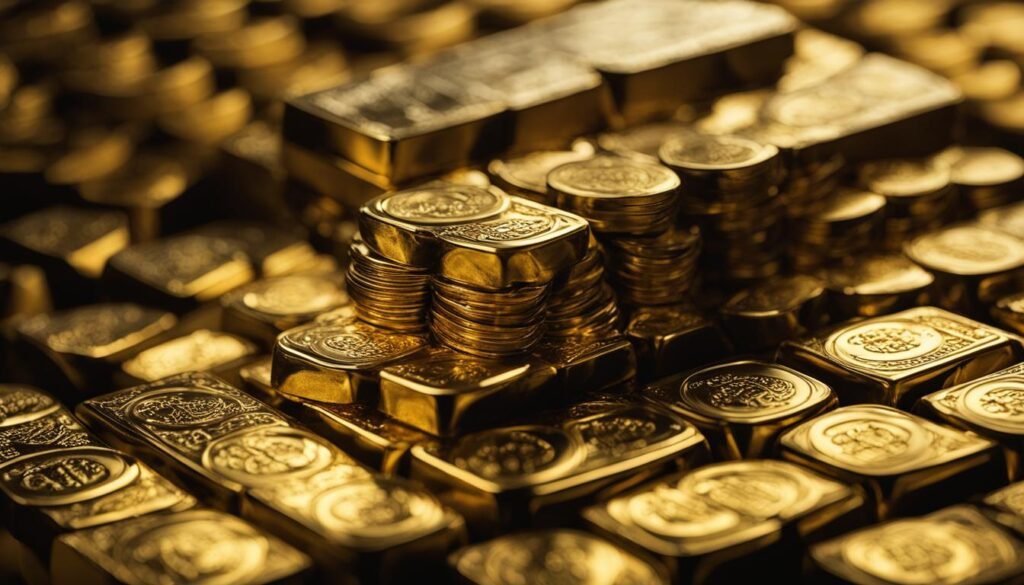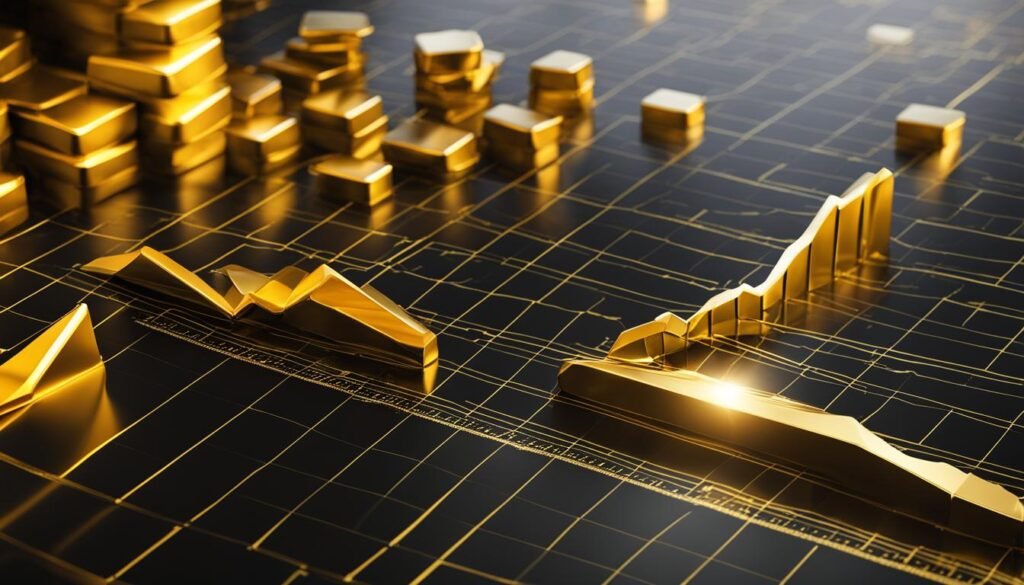The allure of gold has spanned centuries, retaining its status as a cornerstone in the commodity market.
Investors and analysts alike scrutinize gold market analysis in an effort to predict and understand the fluctuations that characterize this precious metal’s pricing.
Whether viewed as a bastion of stability or a lucrative gold investment opportunity, the forces influencing gold prices are multifaceted and extend well beyond basic economic principles.
Intrinsic to precious metal pricing is the interplay between several critical determinants. From the investment demand that sees gold as a hedge against inflation to the impacts of supply shifts and central bank reserves, each factor contributes to a complex narrative of valuation.
Furthermore, considering that gold is dollar-denominated, the strength of the U.S. dollar emerges as a significant price influencer, perpetuating gold’s profile as both an asset and a currency alternative.
Key Takeaways about Gold Price Factors
- Investment demand is a driving force in gold pricing, reflecting its status as a hedge against inflation.
- The U.S. dollar’s strength is inversely proportional to gold prices, with weaker dollar periods often yielding higher gold values.
- Global jewelry and industrial demand exert considerable influence on the precious metal’s market dynamics.
- Central bank reserves are pivotal in gold supply and demand, often setting the tone for larger market movements.
- Understanding market volatility and economic indicators can enhance strategic gold investment approaches.
- A comprehensive gold market analysis is essential for navigating the intricacies of precious metal pricing.
The Timeless Allure of Gold as an Asset
The reverberating appeal of gold transcends ages and economies, persisting as a cornerstone of financial stability amidst a changing fiscal landscape.
Dating back to ancient civilizations, gold’s historical value has been a consistent symbol of wealth and prosperity, ingrained within the fabric of societies worldwide.
In today’s dynamic market, gold continues to prove its worth as a multifaceted asset of enduring value.
Historical Stability and Enduring Value
Gold’s storied past is rich with testament to its ability to withstand the test of time. As currencies rise and fall, gold perpetually emerges as a bastion of intrinsic value, offering a compelling narrative of asset diversification.
This venerable commodity is not solely reliant on economic fluctuation but is underpinned by an immutable allure that has captured the human imagination for millennia. Its legacy is one of dependability and unwavering relevance in an ever-evolving world.
Gold’s Versatility in Modern Finance
In the realm of modern finance, gold’s role expands farther than a mere passive investment. Its applications are numerous, embedding the precious metal deeply within various facets of technological innovation.
Buy Gold Online: The Smart and Secure Way
Discover the safest and most reliable strategies to buy gold online. Make informed investment decisions and secure your financial future today!
Learn MoreFrom sophisticated medical devices to crucial components in the latest electronic gadgets, gold’s conductivity and resistance to corrosion make it an indispensable resource in technology. This physical attribute fortifies gold’s position as an investment with tangible utility, bolstering its desirability and practicality in the current age.
| Aspect of Gold | Role in Finance | Real-World Application |
|---|---|---|
| Store of Value | Long-term investment preservation | Retaining purchasing power over decades |
| Conductivity | Enabling high tech devices | Smartphones, computers, aerospace technology |
| Aesthetic Appeal | Luxury goods and high-value assets | Jewelry, collectibles, and heirlooms |
| Liquidity | Readily exchangeable asset | Global markets and widespread acceptance |
The synthesis of aesthetics and utility, the eternal and the innovative, grounds gold as not just a relic of the past, but a bridge to the future—a testament to its profound significance within the annals of human wealth and progress.
10 interesting facts about factors that influence gold prices
- Gold prices typically have an inverse relationship with the U.S. dollar. When the dollar weakens, gold prices tend to rise, and vice versa.
- Demand for gold jewelry, especially in countries like India and China, can significantly impact global gold prices. In India, gold jewelry accounts for approximately 50% of annual gold demand.
- Gold is often seen as a safe-haven asset during times of economic uncertainty or geopolitical turmoil, which can drive up its price.
- Interest rates have a notable influence on gold prices. Generally, there is a negative relationship between gold prices and interest rates, as higher rates make yield-bearing assets more attractive.
- The monsoon season in India can affect gold prices globally. Good monsoons lead to better crop yields, increasing rural income and gold demand in India, a major gold consumer.
- Central bank policies, particularly regarding gold reserves, can impact gold prices. Increased buying by central banks can drive up demand and prices.
- Gold mining supply plays a role in pricing, though its impact is often less immediate than demand factors. Changes in mining output can affect long-term price trends.
- The opportunity cost of holding gold versus other assets influences investment demand. When returns on stocks, bonds, and other investments look more favorable, gold’s appeal may diminish.
- Inflation expectations significantly affect gold prices. Gold is often viewed as a hedge against inflation, so higher inflation expectations can increase gold demand and prices.
- Technical trading factors, such as price momentum and market positioning, can influence short-term gold price movements, especially in the futures markets.
These diverse factors demonstrate the complex nature of gold pricing, reflecting its role as both a commodity and a financial asset.
Gold Price Factors and Investor Sentiment
Understanding the dynamics of gold prices requires a multifaceted approach, one that considers market volatility, investor behavior, price elasticity, and gold’s role in inflation hedging. The intricate web of these elements shapes the market landscape, influencing how gold is perceived and valued by investors across the globe.
Investor Behavior and its effect on the gold market cannot be overstated. In times of economic uncertainty, the tendencies to flock towards or away from gold as an investment can dramatically sway its price. Moreover, the belief that gold can act as a hedge against inflation often underpins investment strategies, even when the historical correlation between gold prices and inflation rates is tenuous at best.
The Price Elasticity of gold is another critical factor. It refers to the responsiveness of the quantity demanded or supplied of gold to a change in its price. Notably, gold exhibits inelastic characteristics – price changes have less impact on supply and demand compared to other commodities. However, price elasticity can vary with market conditions, primarily influencing investor attitudes toward buying or selling.
Gold remains a sought-after commodity for those seeking to safeguard their assets against the capricious nature of Market Volatility. In volatile markets, gold’s allure often shines brighter, commanding attention as a safe haven for wealth preservation.
Below is a table outlining the relationship between various factors and investor sentiment driving the gold market:
| Factor | Influence on Investor Sentiment | Implications for Gold Prices |
|---|---|---|
| Market Volatility | Increases attractiveness of gold as a safe investment. | Potential rise in prices due to higher demand. |
| Price Elasticity | Instills confidence due to low volatility in quantity demanded or supplied. | Stable prices, with less susceptibility to shock-induced spikes or dips. |
| Inflation Expectations | Boosts the perceived necessity of gold as a hedge. | Can lead to an uptick in demand, thereby increasing prices. |
| Interest Rates | Lower rates often divert investments from yield-generating assets to gold. | Reduced interest rates could prop up gold prices. |
In summary, these elements constitute a complex ecosystem where investor sentiment and economic indicators converge, sculpting the contours of the gold market. As investors navigate through the uncertainties of financial markets, gold’s timeless appeal endures, underpinned by its multiple roles as a diversifier, a protector of wealth, and a symbol of prosperity.
Central Bank Gold Reserves Impacting the Market
As pivotal actors in the global financial ecosystem, central banks exert considerable influence over the gold market. Following the departure from the gold standard, these institutions have increasingly turned to gold to diversify their monetary reserves. The strategy adopted by these banks can lead to significant fluctuations in the demand for gold and correspondingly, its price.

Moreover, the rise of gold in electronics and other technological applications underscores gold’s multifaceted role beyond mere decoration. The unique properties of gold, including corrosion resistance and high conductivity, make it a vital component in consumer goods, medical devices, and intricate electronic apparatuses. It is this dual demand from both consumers and industry that intricately weaves gold into the fabric of global economic trends.
| Industry | Demand Influence | Typical Gold Usage |
|---|---|---|
| Jewelry | High influence on price, with cultural and fashion trends as catalysts | Ornamental pieces, watches, and heirlooms |
| Electronics | Steady demand due to technological advancements | Component connectors, memory chips, and plating |
| Medical Devices | Growing market with innovation in medical technology | Diagnostic equipment and life-support devices |
| Consumer Goods | Moderate impact with variability based on economic climate | High-end accessories and luxury items |
In essence, the symbiotic relationship between the glitter of consumer aspirations and the gleam within high-tech devices establishes gold’s valor not only as a precious metal but as an industrial commodity. As global economies march forward, the interplay of consumer goods and gold will invariably continue to influence its market trajectory.
Economic Uncertainty and Wealth Protection
When financial landscapes are tumultuous and confidence in traditional investments wavers, individuals and institutions alike seek refuge in dependable assets. Gold has long been regarded as a stalwart of security during such times, earning its reputation for wealth preservation and serving as a pivotal player in the articulate crafting of diversified portfolios.
The allure of safe-haven assets is never more pronounced than during periods of economic uncertainty. Investors lean into the historical resilience of gold, and its propensity to weather fiscal storms largely unscathed becomes incredibly valuable. While it is known that no single investment offers total immunity against market fluctuations, gold’s contra-cyclical nature offers a semblance of balance amidst instability.
The Safe-Haven Appeal During Recessionary Times
Reaching back through decades of economic ebb and flow, gold’s gleaming constancy has provided an anchoring force. Its inertness to significant value degradation in the face of recessions delineates gold as a safe-haven asset. Unlike many assets that may depreciate, gold typically sustains its worth or appreciates, making it a beacon for those aiming to safeguard their capital.
Gold Investment as a Diversifier in Portfolios
Understanding the mechanics of portfolio diversification is crucial to risk management and investment success. By incorporating gold into an investment mix, the asset not only introduces a different asset class but also brings its unique inverse relationship with other securities like equities and bonds. In turn, gold offers a non-correlative buffer against the synchronous dips those assets may experience during hard economic times.
Championed for its stabilizing effect on investment portfolios, gold stands firm as a universally esteemed commodity, ready to hold the line against escalating economic uncertainty and solidifying its role in wealth preservation.
ETFs and Investment Demand
The advent of exchange-traded funds (ETFs) has ushered in a new age for gold investment, profoundly influencing market dynamics and trends. As these financial vehicles grant unprecedented accessibility to gold as an investment, their pertinence in shaping the precious metal’s market cannot be undervalued.
The Influence of Exchange-Traded Funds on Gold Prices
ETFs, particularly those like the esteemed SPDR Gold Trust, have become pivotal in the gold market by providing a mechanism for sizable gold quantity holdings. These funds mirror the performance of the price of gold, offering both liquidity and transparency to investors. ETFs’ holdings are so significant that their buying and selling activities can directly impact gold’s market price, demonstrating a powerful vehicle for collective investment trends.

Physical Gold vs. Mining Company Shares in ETFs
In the realm of ETF investment, two distinct paths are discernible: ETFs that hold physical gold and those that own shares of mining companies. While the former provides a direct exposure to the metal’s price fluctuations, the latter offers a nuanced approach, affected by not only gold’s market value but also the operational performance and growth prospects of mining entities.
Physical Gold ETFs:
- Investors hold a proportionate share of physical gold.
- Designed to track and reflect the price of the commodity itself directly.
- SPDR Gold Trust, holding one of the largest physical gold reserves, serves as a prime example of such ETFs.
Mining Shares ETFs:
- Investors hold equity in a variety of gold mining companies.
- These funds can diversify risk, as they are not solely tied to the price of gold but also consider the performance of the mining sector.
- Subject to both gold price and individual company performance, which introduces an additional layer of volatility.
The dichotomy between these types of gold exchange-traded funds underscores their impact on the investment landscape, providing a spectrum of options for investor engagement with this timeless asset class.
Examining Gold Production and Mining Costs
The intricate dynamics of gold mine production and its subsequent influence on the global gold supply cannot be overstated. As we delve deeper into the nuanced aspects of mining economics and the environmental impact associated with extracting this lustrous metal, the picture becomes clearer regarding the factors that define the costs and supply chain of this precious commodity.
Worldwide Gold Mining Landscape
The map of global gold production is dotted with significant contributions from countries like China, Russia, Australia, and the United States. Each of these nations has developed its own infrastructure and investment strategies to harness their gold reserves, often contending with the varying costs of labor, regulatory frameworks, and technological advancements.

Environmental and Economic Challenges in Mining
The pursuit of gold brings with it a range of economical and environmental considerations. Striking a balance between profitability and sustainability presents a complex challenge for miners and investors alike. Mining operations face ever-increasing scrutiny as they strive to minimize their ecological footprint while maintaining an economically viable output.
| Country | Annual Gold Production (tons) | Mining Costs (USD per ounce) | Environmental Initiatives |
|---|---|---|---|
| China | 370 | 950 | Reforestation Programs |
| Russia | 300 | 800 | Waste Management Improvements |
| Australia | 330 | 700 | Land Rehabilitation |
| United States | 200 | 750 | Stronger Regulations on Discharges |
The table above encapsulates the interplay between production levels, costs, and conscientious environmental practices. As we witness shifts in the mining economics landscape, these metrics serve as key indicators of the direction in which the gold mining industry is headed, influencing the accessibility and price points of this precious resource on a global scale.
The Intangible Value of Gold
Gold has long been revered for more than its glowing luster and malleability. Its power to fascinate exceeds what can be seen or touched — it resides in symbolic wealth, carried forth through centuries. This allure is not merely due to the material’s scarcity or its utility, but from a deep social construction of value that crowns gold as an eternal asset.
The aspect of gold’s intrinsic value is woven into human history. Civilizations across time have equated gold with affluence and societal status — a tangible representation of power and stability. Yet, interestingly, this value largely hinges on societal consensus — an unspoken but universally accepted assurance that gold is valuable simply because we all agree it is. This agreement ascends above economic principles, anchoring gold as a symbol within our collective conscience.

Beholding this commodity also stirs feelings of grandeur and permanence that are well-anchored in the psyche of our species. The desire for gold, thus, goes beyond practicality. It fulfills a human need for something that embodies both prosperity and the artistic expressions of our culture. In the spheres of jewelry making and the flourish of technology, gold continues to find its space not only for its functional properties but also for its implied richness.
Gold is perpetual, sovereign among elements, accumulating worth simply through its existence and our enduring belief in its potency and promise.
- The pure essence of gold creates a layer of trust in its enduring value.
- Historic reverence of gold as an emblem of affluence upholds its status as a prized asset.
- Aesthetic value and technological indispensability enhance its contemporary importance.
As such, gold defies a simple valuation tethered to its physicality. Whether as intricate works of art or as sophisticated electronic components, gold’s worth is amplified by a complex fabric of historical significance, cultural depth, and its capacity to captivate. Gold’s worth is not just rooted in economics but bloomed through an enduring enchantment — a symbolic wealth where every ounce is steeped richly in the social construction of value.
Short-Term Volatility vs. Long-Term Value
The landscape of gold price trends often exhibits a dual character, oscillating between the immediate impacts of market volatility and the steadier, overarching arc of long-term value. Market participants witness these two sides of the precious metal as a reflection of contrasting trading sentiment and differing investment horizons.
Instances of market dips and peaks are common, crafted by the agile hands of momentum trading and the emotional undercurrents of investor sentiment. These fluctuations are the essence of short-term volatility that at times beleaguers the gold market.
Yet, despite this tumultuous environment, gold manages to retain an impressive appetite among investors, primarily due to its historical resilience against the ebb and flow of economic cycles.

Delving deeper into this dichotomy, here’s a detailed illustration of how gold’s characteristics cater to both sides of the investment spectrum:
- For day traders, the allure lies in leveraging gold’s short-term price movements, which can be influenced by geopolitical tensions, currency fluctuations, and market news.
- Conversely, for those with a longer investment horizon, gold is a bastion of stability, an asset that has sustained its value over millennia, often acting as a bulwark against inflation and financial downturns.
This intrinsic feature of gold attracts a diverse array of individuals and institutions, each looking to either capitalize on its immediate momentum or to reinforce a portfolio against imminent uncertainties of the future markets.
In reality, distinguishing between gold’s momentary volatility and its enduring worth is crucial to understand which cross-section of the market an investor aligns with. Invariably, acknowledging this contrast becomes pivotal in crafting strategies that are sensitive to immediate market pulses while remaining cognizant of enduring value trends.
Inflation: A Weak Correlation with Gold Prices
It is a commonly held belief that gold is a steadfast hedge against inflation, with rises in inflation rates often assumed to correlate directly with an uptick in gold performance. However, a meticulous analysis of economic indicators and historical data reveals a more nuanced relationship.
The assumption that a surge in inflation predicates a commensurate increase in gold prices has not consistently held true. For instance, the year 2022 witnessed an anomaly in this expected pattern, presenting evidence that complicates straightforward market predictions.

While inflation rates soared, creating an economic atmosphere rife with speculation, gold prices did not experience the anticipated rise. This divergence suggests that additional factors are in play, exerting more immediate influence over gold prices than inflation alone. Notably, market volatility, geopolitical tensions, and intervening economic indicators such as interest rates have demonstrated significant short-term impact on gold’s valuation.
Considering the multifaceted elements that affect gold prices, market predictions become less straightforward. Instead of viewing gold solely as an inflationary countermeasure, examining its responsiveness to wider financial currents offers a more accurate understanding of its performance in various economic climates. Below is a summarized overview that highlights the complex interaction of factors influencing gold’s market behavior:
| Year | Inflation Rates | Gold Price Trend | Market Volatility | Interest Rates |
|---|---|---|---|---|
| 2022 | Rising | Declining | High | Increasing |
This table mirrors the incongruity between gold prices and inflation, highlighting the crucial influence of volatility and interest rates. While inflation may figure into long-term considerations for gold investors, current evidence suggests that its impact is not as immediate or predictable as once thought. Consequently, astute observers and investors may benefit from a comprehensive perspective that considers a broad range of macroeconomic factors when evaluating gold’s potential trajectories.
Interest Rates: The Inverse Relationship with Gold
Understanding the delicate balance between interest rates impact and gold demand is crucial for investors navigating the intricacies of the market. When the Federal Reserve announces a policy shift that affects interest rates, the gold market often exhibits an instant reaction.
Given that gold does not offer yield, low-interest rate environments tend to make gold a more attractive investment as opposed to yield-bearing assets since the opportunity cost of holding gold diminishes.
The inverse relationship between interest rates and gold prices is particularly evident in how gold responds to Federal Reserve policy changes. In periods of rising interest rates, gold’s allure tends to wane as investors gravitate towards assets that benefit from higher yields. Conversely, when the Federal Reserve cuts rates, investors often seek refuge in gold, driving up its demand and price.
“As interest rates rise, the cost of holding non-yielding bullion increases, leading to a reduction in gold demand.”
The year 2022 proved to be a textbook example of this dynamic. The Federal Reserve implemented a series of interest rate hikes to combat inflation, which corresponded with a noticeable dip in gold demand. These hikes drew investors towards other securities that provide interest income, verifying the competitive impact that rising rates have on gold.
- The attractiveness of gold decreases as interest rates climb, prompting investors to pursue yield-bearing assets.
- Federal Reserve policies can swiftly alter the investment landscape, influencing the directional movement of gold prices.
- Gold serves as a strategic investment component during low-interest rate periods, shoring up demand.
While the correlation between interest rates and gold prices is apparent, savvy investors observe other market indicators and geopolitical events alongside Federal Reserve actions to gauge the full scope of gold’s investment potential.
The Global Gold Supply: Less Rare than Consumable?
While gold often conjures images of scarce treasure, gold production statistics suggest a different story. Global gold supply has remained robust, with yearly mining endeavors consistently replenishing stockpiles.
This enduring replenishment challenges conventional wisdom suggesting that rarity is the primary driver of gold’s value. In a stark contrast to consumable commodities, which are used and diminished, gold’s permanence contributes to a certain market abundance, defying the typical supply-demand economics.
The persisting global gold supply is due not only to ongoing mining activities but also to gold’s recyclability and the cultural tendencies to hoard gold rather than consume it. Unlike oil or agricultural products, which are used up, gold remains principally intact through countless exchanges and uses. These factors together influence gold’s unique status in the global marketplace.
“Gold is unlike any other consumable commodity. It does not perish, tarnish or corrode, ensuring that the gold mined thousands of years ago is still in existence today.”
Given this context, the question arises: How does the market react to gold’s abundance? While in most cases, commodity prices drop as supply increases, gold deviates from this trend. This idiosyncratic behavior can be attributed to gold’s historical and cultural significance, its utility as a financial hedge, and its role in the diversification of investment portfolios.
| Year | Global Gold Production (metric tons) | Gold Recycling (metric tons) | Total Gold Supply (metric tons) |
|---|---|---|---|
| 2019 | 3,300 | 1,300 | 4,600 |
| 2020 | 3,200 | 1,200 | 4,400 |
| 2021 | 3,400 | 1,400 | 4,800 |
| 2022 (Estimate) | 3,250 | 1,250 | 4,500 |
The above table provides a snapshot of the recent global gold supply, revealing a consistent influx of newly mined gold coupled with a significant contribution from recycled materials. These figures solidify the concept of gold’s market abundance.
Despite the large quantities available, the value of gold remains high, with market trends showing sustained or even increased valuations over time. This paradox can lead to fascinating discussions on what factors, beyond simple production and availability, propel gold’s enduring value.
To sum up, while gold might bear some resemblance to consumable commodities in terms of market dynamics, its longevity and consistent global supply position it uniquely within financial systems. Understanding these nuances is crucial for investors who consider gold a part of their asset allocation strategy. As market conditions fluctuate, gold’s allure as a stable commodity continues to hold a timeless appeal.
Conclusion
In the intricate tapestry of the commodity market, gold maintains a lustrous position that is multifaceted by nature—treasured by societies throughout the ages and now, held as a beacon of speculation in the investment world.
Unlike most commodities that are depleted through consumption, gold’s existence is nearly eternal, constantly circling through markets and vaults, contributing to its enigmatic presence in economic sectors. The culmination of our analysis underscores gold’s enduring persona as both a safe-haven asset and a noteworthy player in the realm of strategic investing.
Gold’s Unique Standing in the Commodity Market
Gold’s distinction lies in its historical consistency as a repository of value, even amidst the ever-churning waves of market trends and economic developments. This time-honored steadiness offers solace to those seeking refuge in the asset’s proven resilience, which aligns seamlessly with a robust approach to portfolio management and financial planning.
Clearly, the dual appeal of gold, spanning the spectrum from ornamental to financial, ensures its analysis—gold market analysis—remains pivotal for informed investment decisions.
Practical Investing Tips and Portfolio Considerations
For the savvy investor, weaving gold into the fabric of a diversified portfolio is less a matter of indulging in the metal’s radiance and more about strategic allocation. Maintaining a measured percentage of gold can not only temper risk but also enhance the potential to thrive during periods of uncertainty.
The key is to comprehend the nuanced dance gold performs with economic forces, thereby cementing its role as a linchpin in the realm of strategic investing. Consequently, it holds a gilt edge in safeguarding assets against unforeseen financial turbulence—an irrefutable asset in the sophisticated investor’s toolkit.
FAQ about Gold Price Factors
What are the principal factors affecting gold prices in the commodity market?
Gold prices are influenced by investment demand, supply and demand dynamics, central bank reserves, dollar denomination, and it being seen as a hedge against inflation. Other factors include jewelry and industrial demand, economic uncertainty, and the performance of ETFs.
How does historical stability contribute to gold’s appeal as an investment asset?
Gold’s historical stability endows it with enduring value, making it a coveted asset for portfolio diversification and financial stability, especially in modern finance where it aids in safeguarding wealth during economic volatility.
How does investor sentiment impact gold market prices?
Investor behavior and the perception of gold as an inflation hedge, despite a weak correlation, profoundly influence gold prices. Market volatility and momentum trading can also affect investor sentiment, driving price elasticity.
In what ways do central bank reserves affect the gold market?
Central banks play a critical role in the gold market by diversifying their monetary reserves, particularly post gold standard era. Hefty purchases of gold by central banks can significantly influence gold’s market demand and pricing.
Can you explain gold’s inverse relationship with the U.S. dollar?
Gold is denominated in U.S. dollars, creating an inverse relationship where typically, a strong dollar may lead to lower gold prices, while a weaker dollar could result in higher gold prices, positioning gold as a strategic hedge against inflation and currency devaluation.
How does demand from the jewelry and industrial sectors drive gold prices?
The jewelry market, particularly from countries like India and China, and industrial applications, such as medical devices and electronics, generate substantial demand for gold, impacting its market value based on supply and demand principles.
Why is gold considered a safe-haven during times of economic uncertainty?
During economic recessions and market volatility, gold is preferred for its reputation in value preservation and stability, enhancing its appeal as a safe-haven asset capable of protecting wealth.
What role do ETFs play in gold’s investment demand?
ETFs, especially those like the SPDR Gold Trust, provide accessible ways to invest in gold, either through physical gold or mining company shares, significantly influencing gold’s investment demand and price volatility.
How do gold production and mining costs affect gold prices?
Gold prices are closely tied to the challenges in mining, such as increased environmental impacts and extraction difficulties, which can elevate production costs, potentially influencing gold’s market price.
What intangible factors contribute to the value of gold?
Beyond its economic and practical applications, gold’s intrinsic value is enhanced by its symbolic representation of wealth and power, and its historical significance contributes to the societal perception of its value.
How do short-term volatility and long-term value differ in the context of gold?
Short-term volatility in gold prices is influenced by dynamic market forces and investor sentiment, while its long-term value remains supported by historical stability and its role as a hedge against financial and economic uncertainties.
Is there a significant correlation between inflation and gold prices?
Despite popular belief, inflation does not have a strong correlation with gold prices. Other factors like market volatility, interest rates, and currency valuation often play more decisive roles in determining gold’s price.
How do interest rates affect gold prices?
The inverse relationship between interest rates and gold prices means that when interest rates are low, gold prices tend to be higher, and conversely, when interest rates rise, gold prices can decrease as investors may prefer interest-bearing securities.
Is the global supply of gold considered scarce?
Unlike consumable commodities, most gold ever mined still exists and is continually augmented by ongoing mining. This abundance, along with persistent mining outputs, influences gold’s steady presence in the commodities market.
Source Links
- https://www.investopedia.com/financial-edge/0311/what-drives-the-price-of-gold.aspx
- https://www.investopedia.com/articles/active-trading/031915/what-moves-gold-prices.asp
- https://www.cruxinvestor.com/posts/key-factors-influencing-gold-price



